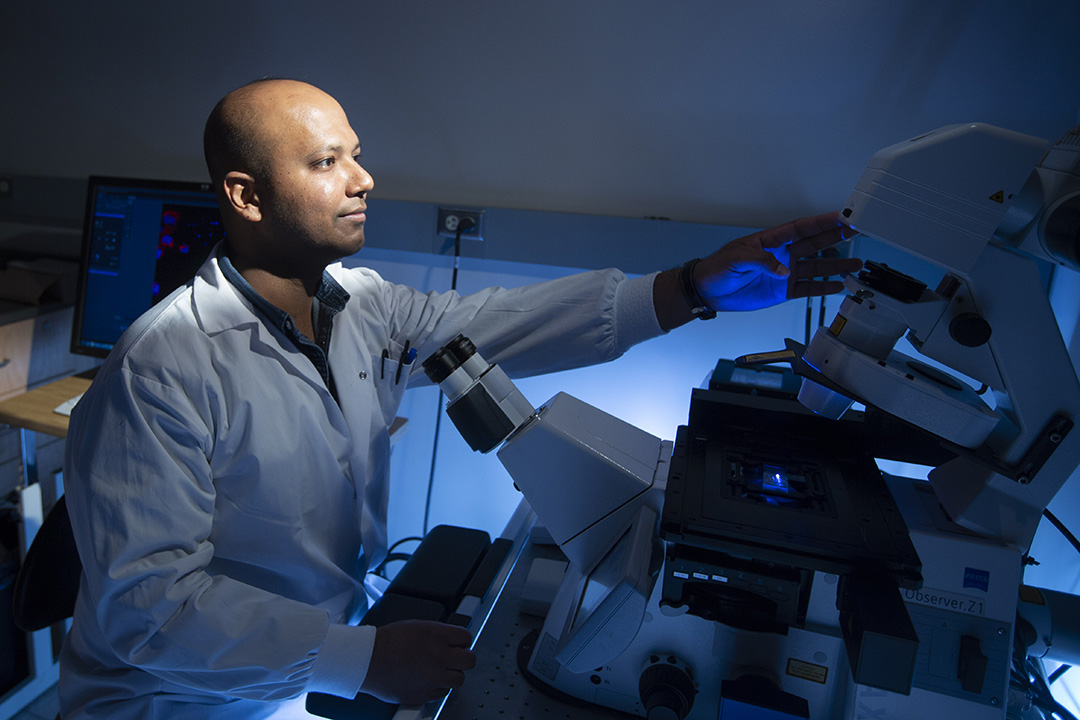
U of S study targets enzyme’s role in breast cancer
With one in nine women expected to develop breast cancer during her lifetime, someone close to you could get the potentially fatal disease, as University of Saskatchewan graduate student Raghuveera Goel knows too well.
By Federica Giannelli“I saw my mother’s best friend passing away in just one month after she was diagnosed with breast cancer,” said Goel, PhD biochemistry student. “That’s why I was drawn to cancer research.”
After coming from India to join biochemistry professor Erique Lukong’s lab in 2014, Goel started investigating the role that an enzyme called SRMS may have in breast cancer. His initial results showed that high SRMS levels correlated with more aggressive cancer, and that SRMS appeared in the breast cancer cells of patients in larger quantities than in adjoining cells.
“Knowledge about SRMS cellular functions has been limited,” said Lukong. “The enzyme was discovered in 1994 but has been understudied for the past 20 years. We are getting close to solving the mystery.”
In a recently published article in the Molecular and Proteomics Journal, Lukong and Goel have been the first to identify and map more than 660 proteins targeted by the SRMS enzyme.
This discovery will help scientists develop treatment strategies that could suppress the activity of SRMS and limit its potential impact on the proliferation of breast cancer cells. The end goal is to offer better tools for early diagnosis and monitoring disease progression.
SRMS belongs to a class of enzymes called tyrosine kinases that target specific proteins within cells. They trigger chemical changes that regulate processes such as cell shape, growth and energy consumption. When they go rogue, these enzymes wreck cellular processes, forcing cells to unruly replication, for example. Past studies have linked the occurrence of cancer to malfunctions of tyrosine kinases.
“Our research has been a big step forward. We didn’t know which proteins the enzyme targets and when, or how,” said Goel. “Now we know.”
The team has used a unique set of tools to complete the mapping of the proteins. They collected data using an advanced mass spectrometer housed at the University of Michigan, and did their analysis with software developed by the University of Toronto. The research is funded by the federal agency NSERC.
The researchers have also customized a peptide array, a new screening tool that helps identify the role of enzymes in proteins. The array, developed with U of S biochemistry professor Scott Napper, may be applied to determine targeted treatments by detecting how SRMS is active in a patient’s cancer.
Despite the promising results, Lukong and Goel caution that more research is needed to fully understand the role of SRMS in breast cancer.
“The next step will be testing how SRMS levels affect different cancer types and identifying how SRMS regulates target protein function in these cancers,” said Goel.
Despite a 44-per-cent reduction in breast cancer death rates since 1987, as reported by the Canadian Breast Cancer Society, early detection and better treatments are paramount for ensuring women’s survival, he said.
He said he was attracted to the U of S by the chance to work with Lukong and by major developments at the U of S College of Medicine including new research labs, acquisition of sophisticated instruments and funding opportunities.
This article first ran as part of the 2018 Young Innovators series, an initiative of the U of S Research Profile and Impact office in partnership with the Saskatoon StarPhoenix.
Federica Giannelli is a graduate student intern in the U of S research profile and impact unit.

